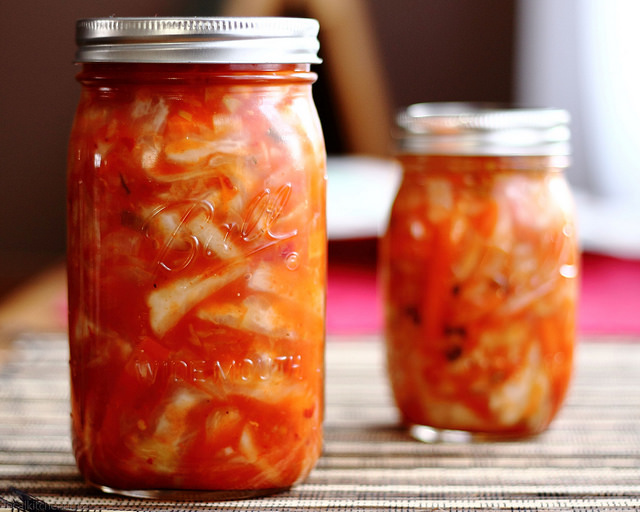KWimchi, or KW-Chi, or a Kimchi for KW
This post was originally written for Bailey’s Local Foods .
I’m very new to the world of fermentation, especially when it comes to foods. I didn’t grow up eating sauerkraut and still find it a bit odd. However, the first time I had kimchi I knew I’d have to learn how to make it (because I’m kind of cheap, but mostly because I love learning how to make new things!). So I took two recipes and made my own version using as many local ingredients as I good. The result is KWimchi, or KW-Chi, or a Kimchi for KW.
 Trying to emphasize the ingredients we have available from local farms this kimchi is a bit more of what
Sandor Katz
would call a
Kraut-Chi
. Regardless of what you call it, it is delicious enough to eat by itself (which I’ve been doing lately!).
Trying to emphasize the ingredients we have available from local farms this kimchi is a bit more of what
Sandor Katz
would call a
Kraut-Chi
. Regardless of what you call it, it is delicious enough to eat by itself (which I’ve been doing lately!).
Our recipe is based on these two:
The Kitchn’s How to Make Easy Kimchi at Home
Nourished Kitchen’s Hot, Salty & Sour: My Kimchi Recipe
- 1 cabbage (napa is the traditional, but I’ve just been using standard cabbage), coarsely chopped
- 3-6 carrots (depends on their size and how much carrot you want), chopped into thin sticks
- 1-3 daikon radishes (same as carrots, it’s your choice how much), chopped into thin sticks
- 2-4 green onions (optional, use them if they’re seasonally available)
- ¼ cup salt
- Kimchi chili paste
- *Or*
- 50g fresh ginger (a decent sized chunk)
- 3-6 cloves garlic
- 1 tbs. fish sauce
- 1 tbs. honey
- 25-100g chili peppers (you’re going to have to experiment to find your desired heat level, and it also depends on your peppers)
- Chop up the cabbage and sprinkle with most of the salt, saving a bit. Massage the salt into the chopped cabbage, then cover with water. If need be place something heavy on top of the cabbage to keep it submerged. Leave it in the salt water for at least 30 minutes and as long as 2 hours. Rinse it under cold water and drain all the water.
- Make the paste by pureeing the ginger, garlic, fish sauce, honey, and chili peppers. Add the remaining salt. (skip this step if using a purchased kimchi paste).
- Squeeze any remaining water from the cabbage then mix it together with the carrots, radish, and optional green onion in a large bowl. Wearing rubber gloves work the ginger chili paste into the vegetables until all are coated.
- You could eat it now and it would be like a super spicy coleslaw, and you might as well taste it at this point, but press on (pun intended) to the next step. Pack the kimchi into a large jar or crock, pressing down with your gloved hands or some sort of food masher, until brine begins to rise from the vegetables. This takes a while, and if you absolutely can’t get enough liquid from pressing you can add salt water to top up your kimchi.
- In order to ferment properly, the vegetables must be submerged below the liquid. Place a weight of some sort on top of the vegetables to keep them submerged, some people use a smaller jar filled with water, others use a clean stone. I ferment in a large crock and use a ceramic coffee container to weigh down the veggies. Cover the jar (loose enough to allow gas to escape) and let it ferment for about a week. Experiment with length of ferment by tasting it as it progresses. When it tastes good (to you or your friend) put it in the fridge to slow fermentation. If you don’t eat it you might keep it for several months. Mine lasted one week because we ate it that quickly!




Leave a Reply